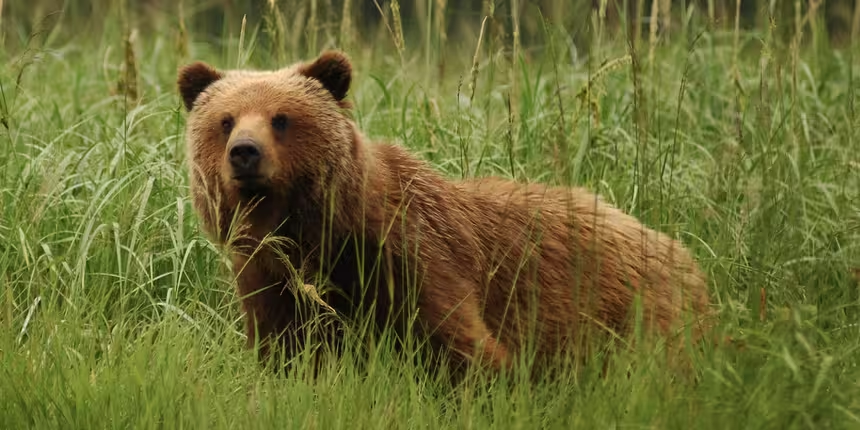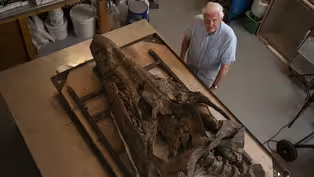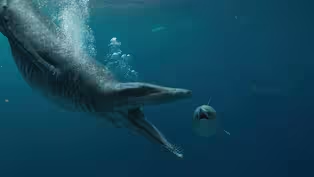
Discovering the Secrets of a Jurassic Sea Monster
Clip: Season 42 Episode 11 | 3m 2sVideo has Closed Captions
Sir David Attenborough uncovers the secrets of the pliosaur, a monstrous marine predator.
Sir David Attenborough uncovers the secrets of the pliosaur, a monstrous marine predator. The pliosaur is believed to have been over 30 feet in length, similar to a double-decker bus.
Problems playing video? | Closed Captioning Feedback
Problems playing video? | Closed Captioning Feedback
Major support for NATURE is provided by The Arnhold Family in memory of Henry and Clarisse Arnhold, Sue and Edgar Wachenheim III, The Fairweather Foundation, Charles Rosenblum, Kathy Chiao and...

Discovering the Secrets of a Jurassic Sea Monster
Clip: Season 42 Episode 11 | 3m 2sVideo has Closed Captions
Sir David Attenborough uncovers the secrets of the pliosaur, a monstrous marine predator. The pliosaur is believed to have been over 30 feet in length, similar to a double-decker bus.
Problems playing video? | Closed Captioning Feedback
How to Watch Nature
Nature is available to stream on pbs.org and the free PBS App, available on iPhone, Apple TV, Android TV, Android smartphones, Amazon Fire TV, Amazon Fire Tablet, Roku, Samsung Smart TV, and Vizio.
Buy Now

Explore More Ways to Watch
Bring the beauty and wonders of wildlife and natural history into your home with classic NATURE episodes.Providing Support for PBS.org
Learn Moreabout PBS online sponsorshipThought to have been over 30 feet in length, similar to a doubledecker bus.
In the late Jurassic, Europe was an archipelago of islands, much closer to the equator than it is today.
It seas were warm, shallow, and teeming with life.
And in these waters underneath my feet lurked the ultimate marine predator, the pliosaur.
Unlike dinosaurs that lived on land, these colossal marine reptiles spent their whole lives in the ocean.
Thought to have been over 30 feet in length, similar to a doubledecker bus.
They had long, broad flippers; short, strong necks; huge heads, and enormous jaws.
But there's still a lot we don't know about these great sea monsters, which is why this new discovery is so important.
Steve believes that the entire pliosaur may still be inside the cliff, but it's the skull on which he's concentrating.
A skull can reveal more about an animal than any other part of its skeleton.
Finding a complete specimen is rare, but it can tell us a great deal about how the animal lived.
- It's quite hot and dirty work.
- [Host] Steve and Chris think they will have about three weeks to dig the fossil out before the storms of late summer come.
- This is a learning curve.
I thought, stupidly, that it wouldn't be quite as hard as this.
We're probably over a meter in.
There's the skull there, just behind me.
It's up to us now to get it out without any damage.
- [Host] If the skull is successfully extracted, it'll be taken to the Etches Collection Museum in Cambridge, which was founded by Steve in 2016 and now contains nearly 3000 fossils from the Jurassic period.
Preview of Attenborough and the Jurassic Sea Monster
Video has Closed Captions
Preview: S42 Ep11 | 30s | Sir David Attenborough and experts unearth the fossil of the largest Jurassic predator. (30s)
T-Rex vs. Jurassic Sea Monster
Video has Closed Captions
Clip: S42 Ep11 | 3m 3s | Who would win in a fight: the Tyrannosaurus Rex or the Pliosaur? (3m 3s)
Providing Support for PBS.org
Learn Moreabout PBS online sponsorship
- Science and Nature

Explore scientific discoveries on television's most acclaimed science documentary series.













Support for PBS provided by:
Major support for NATURE is provided by The Arnhold Family in memory of Henry and Clarisse Arnhold, Sue and Edgar Wachenheim III, The Fairweather Foundation, Charles Rosenblum, Kathy Chiao and...


